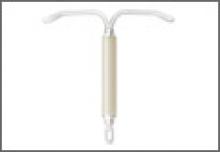› Recommend the 52 mg levonorgestrel-releasing intrauterine device (LNG-IUD) as a first-line treatment for heavy menstrual bleeding. A
› Advise patients with dysmenorrhea that the 52 mg LNG-IUD is an effective nonsurgical treatment. A
Strength of recommendation (SOR)
A Good-quality patient-oriented evidence
B Inconsistent or limited-quality patient-oriented evidence
C Consensus, usual practice, opinion, disease-oriented evidence, case series
CASE Jane K, a 40-year-old multiparous woman, is seeking treatment for heavy menstrual bleeding and cramping, both of which have troubled her for 4 years. Another physician had given her oral contraceptive pills (OCPs) to decrease the pain and bleeding, she reports, but she has difficulty remembering to take a pill every day.
On physical exam, you note an enlarged uterus (approximately 16-week size). A pregnancy test is negative, her thyroidstimulating hormone level is normal, and her hemoglobin is 9 g/dL. Transvaginal ultrasound reveals multiple fibroids.
What can you offer her?
At some point in their reproductive years, 10% to 15% of women experience heavy menstrual bleeding (HMB), or menorrhagia.1,2 In fact, HMB and dysmenorrhea are among the most common reasons for office visits and missed work among women in this age group.3,4 In addition to having a negative impact on quality of life, HMB can cause severe anemia.5
All too often, the suggested solution is a hysterectomy. In fact, 90% of the more than 600,000 hysterectomies performed annually in the United States are for benign disease.6,7 Yet many women with HMB want nonsurgical treatments, and some seek to preserve their fertility. A progestin IUD can often fulfill both of these desires.
An IUD containing 52 mg levonorgestrel (Mirena) has US Food and Drug Administration (FDA) approval both for use as a contraceptive and for the treatment of HMB in women who want intrauterine contraception.8 Recent studies have confirmed its efficacy in treating a wide variety of conditions associated with menorrhagia and dysmenorrhea. In 2013, a smaller, lower dose (13.5 mg) levonorgestrel-releasing IUD (Skyla) received FDA approval as a contraceptive.9 But because this device has been neither tested nor approved for other applications, the following review applies only to Mirena—referred to throughout this article as the LNG-IUD.
A proven (and often superior) treatment for menorrhagia
Leiomyomas, or fibroids—the most common benign tumor of the female genital tract—are a frequent cause of menorrhagia.10 OCPs are often used for the treatment of symptomatic fibroids for women who wish to avoid surgery. When compared with low-dose OCPs for the treatment of menorrhagia secondary to fibroids, however, the LNG-IUD resulted in a significantly greater reduction in blood loss.11
While fibroid size does not appear to decrease significantly after insertion of the device, a systematic review found that menstrual bleeding lessens and hemoglobin levels improve in women with symptomatic fibroids.12,13 The LNG-IUD has also been shown to improve symptoms in women with dysmenorrhea secondary to fibroids.14
Hemostatic disorders. Anticoagulants are vital for women with hemostatic disorders such as Von Willebrand disease, immune thrombocytopenia, or a clotting factor deficiency (See “Is a novel anticoagulant right for your patient?”), but their use may cause or worsen menorrhagia. In such cases, the LNG-IUD appears to be an effective treatment.
In a retrospective case review of 28 women with menorrhagia secondary to various hemostatic disorders, 68% experienced improvement after insertion of the IUD.15 Another study compared women on anticoagulant therapy for cardiac valve disease (N=40) with and without the LNG-IUD. Compared with the control group, those with the IUD were found to have significant increases in hemoglobin levels 3 months after insertion.16
Obesity-related uterine bleeding. Obese women are at higher risk for excessive uterine bleeding, the result of increased conversion of plasma androstenedione to estrogen in adipose tissue. In one study evaluating the use of the LNG-IUD in this patient population, 75% of participants experienced a reduction in bleeding.17
Idiopathic HMB. The IUD is as good as, or better than, other treatments for idiopathic menorrhagia. It results in a significantly higher reduction in both blood loss and days out of work than OCPs.1 The device also reduces blood loss more effectively than oral medroxyprogesterone,18 another common approach to idiopathic HMB; and, compared with hysterectomy, it results in similar patient satisfaction—but lower costs and complication rates.19
In a randomized controlled trial that compared the LNG-IUD with tranexamic acid, mefenamic acid, combined estrogenprogesterone, or progesterone alone over a 2-year period, scores on a menorrhagia symptom scale were significantly higher (indicating greater improvement) in the LNG-IUD group.20


